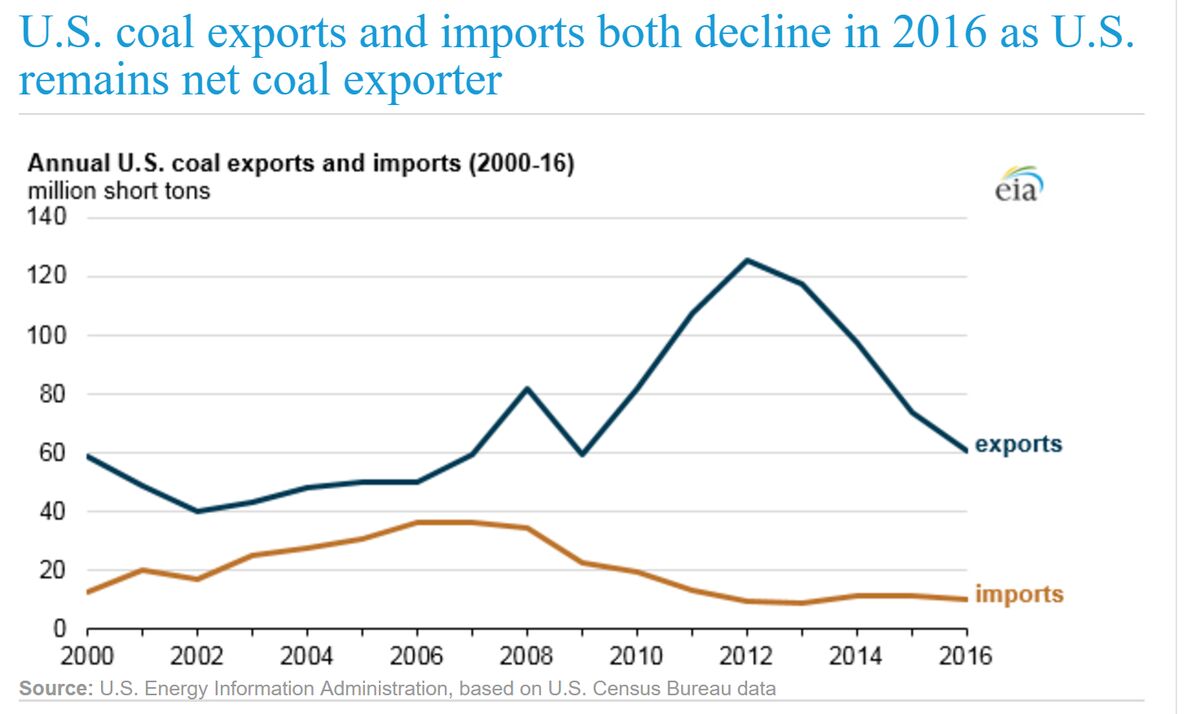Both cheap and abundant, coal is perhaps the least sexy of commodities -- unless you live in a coal-producing state like Wyoming or West Virginia, where the industry is a big employer. From a global perspective, it would be practically impossible to live without coal, which generates about 40 percent of the world’s heat and power.
By now, the drawbacks to coal are well-known. Burning the fuel emits about twice the amount of carbon dioxide as natural gas and 28 percent more pollutants than heating oil. As the world’s biggest source of carbon emissions and a major contributor to global warming, many nations are reducing coal consumption. Growth in global consumption stalled in 2014 for the first time since the 1990s before falling 15 percent in 2015. Last year, U.S. production fell 18 percent from 2015 to the lowest level since 1978, according to the U.S. Energy Information Agency.
The Stream Protection Rule designed during the Obama administration would phase out coal. The U.S. is in a better position than practically any nation to do so due to its vast reserves of crude oil and natural gas, and its increasingly more efficient renewable energy. In this transition, the government could provide funding for career training and jobs in alternative energy industries and their ancillary services, including a growing clean tech industry, for out-of-work coal miners seeking employment.
But now all of this has changed. President Donald Trump signed an executive order on Tuesday reversing the Obama administration’s efforts to cut emissions as well as reversing a rule that the nation’s national security had to account for climate change. In February, the Senate followed the House in voting for a measure to reverse Obama’s regulatory legacy aimed at protecting streams from the effects of coal mining. Trump has vowed to withdraw from the Paris climate pact reached last year by almost 200 countries. If successful, U.S. coal-fired electricity use would increase by an estimated 61 percent, according to the EIA.

Trump attempts to legitimize the regulatory rollback by promoting “clean coal” innovations of which the industry claims could remove as much as 90 percent of the carbon associated with burning coal. But clean coal is not yet proven effective, and the process is expensive.
If Trump really wants to revise coal production in the U.S., maybe he should look to North Korea. As tensions between that country and the world over its nuclear arsenal -- strong enough to threaten not only to its neighbors but the U.S. -- the time may be right for the U.S. to persuade other countries to stop buying coal from the so-called Hermit Kingdom.
North Korea borders China, South Korea and Russia by land and Japan by sea. North Korea’s exports increased at an annualized rate of 8.6 percent between 2010 and 2015, from $1.83 billion to $2.83 billion. Coal briquettes are by far North Korea’s top export, accounting for 34 percent to 40 percent in recent years, with almost all of it shipped to China. North Korea’s top import origins are China, India and Russia. Sanctions on North Korean coal exports and on its top import, refined petroleum, would wreak havoc on the nation’s economy.

What all this means for global coal prices is that they should drop as U.S. production rises and global demand weakens. In the U.S. coal competes with cheap and bountiful shale gas. And even if China aggressively enforces sanctions, less North Korean coal is unlikely to generate a global shortage. China has clamped down on new coal projects and now has the world’s greatest installed wind and solar PV capacity. Furthermore, Pakistan could become the next big producer to replace North Korea, as it has begun to dig up one of the world’s largest deposits of low-grade coal.
Surely, some U.S. coal companies will see an initial boost to their balance sheets, but lower prices will eventually diminish enthusiasm on the equity side as well. There’s also the fact that almost all coal produced in the U.S. is used to generate electricity, but U.S. annual retail sales of electricity have remained stagnant for the last five years while the number of coal fired plants halved. It was not the Obama administration that eliminated coal mining jobs but rather market forces, which Trump cannot change by producing more of an undesired product.
Surely, some U.S. coal companies will see an initial boost to their balance sheets, but lower prices will eventually diminish enthusiasm on the equity side as well. There’s also the fact that almost all coal produced in the U.S. is used to generate electricity, but U.S. annual retail sales of electricity have remained stagnant for the last five years while the number of coal fired plants halved. It was not the Obama administration that eliminated coal mining jobs but rather market forces, which Trump cannot change by producing more of an undesired product.










No comments:
Post a Comment